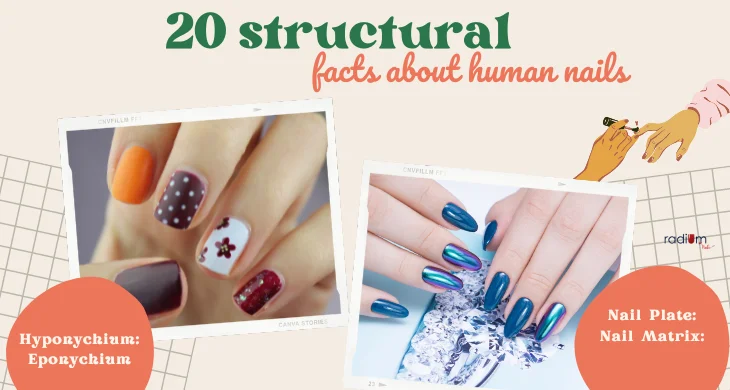Skip to content- Composition: Nails are made up of a protein called keratin, the same substance found in hair & the outer layer of skin.
- Nail Plate: The visible part of the nail is called the nail plate, & it’s composed of tightly packed keratinized cells.
- Nail Matrix: The matrix, located under the cuticle, is the tissue at the base of the nail that produces new nail cells.
- Cuticle: The cuticle is a thin layer of tissue that protects the nail matrix and helps prevent infection.
- Lunula: The white, crescent-shaped area at the base of the nail is called the lunula, & it’s the visible part of the matrix
- Nail Bed: The nail bed is the skin underneath the nail plate; it’s rich in blood vessels that give nail’s their pinkish color.
- Nail Fold: The skin that surrounds the sides of the nails is called the nail fold or lateral nail fold.
- Hyponychium: The hyponychium is the area of skin beneath the free edge of the nail; it helps seal the nail to the fingertip.
- Eponychium: Also known as the “cuticle,” the eponychium is the thin layer of skin that overlaps the lunula & the base of the nail.
- Free Edge: The part of the nail that extends beyond the fingertip is called the free edge.
- Nail Ridges: Sometimes vertical or horizontal ridges appear on the nails due to variations in cell production.
- Pterygium: A pterygium is an overgrowth of the eponychium that attaches to the nail plate, causing irregular growth.
- Nail Growth Rate: Nails grow faster on the dominant hand, and the average rate is about 0.1mm per day.
- Nail Thickness: Nails are generally thickest at the tips and thinnest near the cuticle.
- Nail Plates in Toes: Toenails are generally thicker and more resilient than fingernails.
- Nail Layers: The nail plate consists of multiple layers of compacted keratin cells, similar to shingles on a roof.
- Nail Color: The pinkish color of healthy nails comes from the blood vessels beneath the nail bed.
- Brittle Nails: Brittle nails might result from a lack of moisture or excessive exposure to water and chemicals.
- Nail Disorders: Conditions like onychomycosis (fungal infection) and paronychia (infection around the nail) can affect nail health.
- Nail Growth Phases: Nails go through three phases: the growth phase (anagen), the resting phase (telogen), and the shedding phase (exogen).

